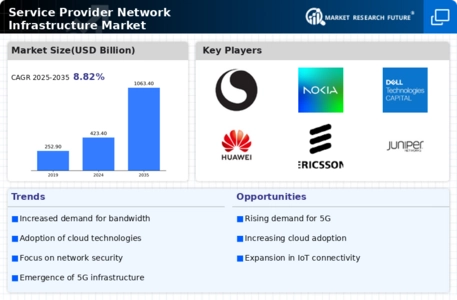Emergence of 5G Technology
The emergence of 5G technology is a transformative force within the Service Provider Network Infrastructure Market. This next-generation wireless technology promises to deliver unprecedented speeds and lower latency, fundamentally changing how consumers and businesses interact with digital services. As 5G networks roll out, service providers are investing heavily in upgrading their infrastructure to support this technology. Recent projections indicate that 5G subscriptions could surpass 1 billion by 2025, underscoring the urgency for service providers to adapt. The deployment of 5G not only enhances mobile connectivity but also enables new applications, such as augmented reality and autonomous vehicles, which require robust network capabilities. Consequently, the Service Provider Network Infrastructure Market is poised for significant growth as providers strive to meet the demands of this evolving technological landscape.
Adoption of Cloud-Based Solutions
The Service Provider Network Infrastructure Market is increasingly influenced by the adoption of cloud-based solutions. Organizations are migrating their operations to the cloud to enhance flexibility, scalability, and cost-efficiency. This shift necessitates a robust network infrastructure capable of supporting cloud services, which in turn drives demand for advanced networking technologies. Data indicates that cloud services are expected to grow at a compound annual growth rate (CAGR) of over 20% in the coming years. Service providers are responding by investing in their network infrastructure to ensure seamless integration with cloud platforms. This trend not only enhances service delivery but also positions service providers to capitalize on the growing market for cloud services, thereby reinforcing their competitive edge within the Service Provider Network Infrastructure Market.
Expansion of Internet of Things (IoT)
The expansion of the Internet of Things (IoT) is a pivotal driver in the Service Provider Network Infrastructure Market. As more devices become interconnected, the demand for reliable and scalable network infrastructure intensifies. IoT applications span various sectors, including healthcare, manufacturing, and smart cities, each requiring robust connectivity solutions. Recent estimates suggest that the number of connected IoT devices could reach over 30 billion by 2030, necessitating significant upgrades to existing network infrastructures. Service providers are thus compelled to enhance their capabilities to accommodate this influx of devices and data traffic. This expansion not only presents challenges but also opportunities for innovation in network design and management, ultimately shaping the future landscape of the Service Provider Network Infrastructure Market.
Increased Demand for High-Speed Connectivity
The Service Provider Network Infrastructure Market is experiencing a surge in demand for high-speed connectivity. This demand is driven by the proliferation of data-intensive applications, such as video streaming and online gaming, which require robust network capabilities. According to recent data, the number of broadband subscriptions has increased significantly, with a notable rise in fiber-optic connections. Service providers are compelled to enhance their infrastructure to meet these expectations, leading to substantial investments in network upgrades and expansions. As a result, the industry is likely to witness a shift towards more advanced technologies, such as 5G and beyond, which promise to deliver faster and more reliable connectivity. This trend not only supports consumer needs but also enables businesses to leverage digital transformation initiatives, thereby further propelling the growth of the Service Provider Network Infrastructure Market.
Regulatory Compliance and Security Enhancements
Regulatory compliance and security enhancements are becoming increasingly critical in the Service Provider Network Infrastructure Market. As data privacy regulations tighten, service providers must invest in their network infrastructure to ensure compliance with these evolving standards. This includes implementing advanced security measures to protect sensitive data and maintain customer trust. Data suggests that The Service Provider Network Infrastructure Market is projected to grow significantly, reflecting the heightened focus on security within network infrastructures. Service providers are likely to adopt more sophisticated technologies, such as artificial intelligence and machine learning, to bolster their security frameworks. This proactive approach not only mitigates risks but also positions service providers as trustworthy partners in the eyes of consumers, thereby enhancing their standing within the Service Provider Network Infrastructure Market.


















Leave a Comment